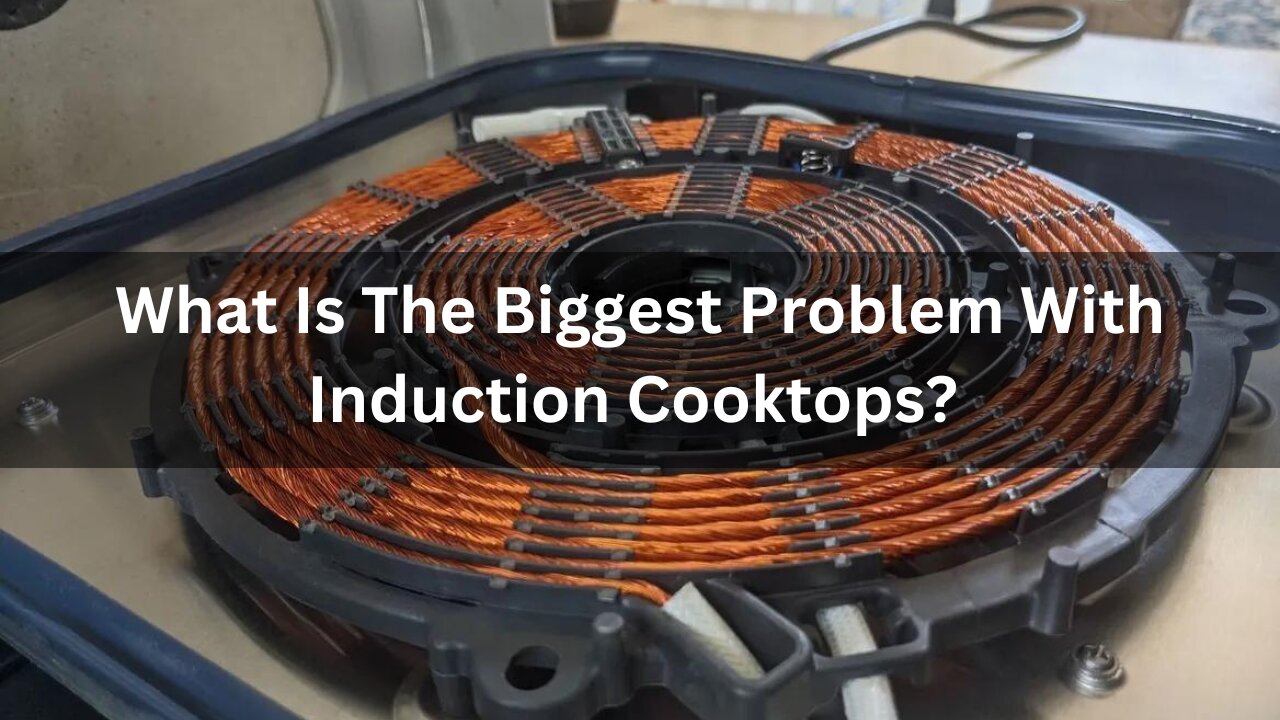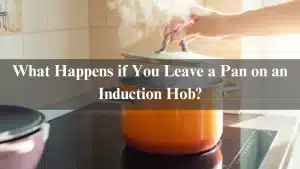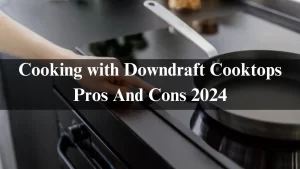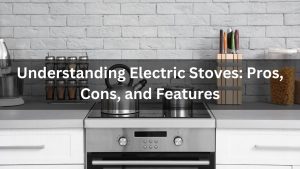The induction cooktop is one of the most remarkable technologies in the kitchen, making your kitchen more attractive and giving you many benefits like fast cooking, health benefits, ease of cleaning, etc. Still, on the other hand, there are some small problem with induction cooktops that we will discuss.
In this fast technology world, induction cooktops are perfect appliances for the kitchen. Still, they have some minor issues like heating issues, control panel issues, and sound beeping, and some of the function problems like E2 error, F1, F2, etc, are the problems of induction cooktops.
We read about many types of cooktop benefits and problems. The most common problem with cooktops is heating issues, mostly in induction cooktops.
Table of Contents
Why Is Cookware Compatibility the Biggest Problem with Induction Cooktops?
The biggest issue with induction cooktops is the need for magnetic cookware. Not all cookware will work on these high-tech surfaces, which means that your trusty old pots and pans may need to be replaced. But this isn’t just a simple swap—finding cookware that’s fully compatible and performs well can be a challenge.
How Induction Technology Works and Its Impact on Cookware
Induction cooktops work by using electromagnetic fields to heat the cookware directly, not the cooktop surface. This requires cookware made of ferromagnetic materials, such as cast iron or magnetic stainless steel. When the pan is placed on the induction stove, it completes the electromagnetic circuit and starts heating.

But if you use non-magnetic cookware, such as aluminum, copper, or glass, nothing will happen. The cooktop won’t detect the pan, and there will be no heat transfer. That’s where the frustration begins for many new induction users, myself included.
The Cookware Surprise: What Doesn’t Work?
When I first installed my induction cooktop, I was surprised to learn that most of my cookware wouldn’t work. Non-magnetic materials like:
- Aluminum pans
- Copper cookware
- Glass pots
…were completely useless on the induction stove. I had to part ways with some of my favorite pots that I’d been using for years. This is where many people get stuck—realizing that their existing cookware collection may be incompatible.
What Happens If You Don’t Use the Right Cookware?
If you don’t use the correct cookware on an induction cooktop, it simply won’t heat. Unlike gas or electric stoves, which will heat up anything placed on them, induction cooktops need magnetic cookware to work. But even if your cookware is labeled as “induction compatible,” you might still encounter issues.
The Problem with Thin or Inconsistent Cookware Bases
Induction cooktops are sensitive to the quality of your cookware. If your pans have thin, uneven bases, or aren’t perfectly flat, you might experience uneven heating or hear the dreaded “clicking” sound, a problem I faced early on. The surface needs full contact with the cooktop to properly conduct heat.
In some cases, the pan might heat slower than expected, or not at all, which can lead to frustration.
| Common Problems with Cookware on Induction Stoves | Solution |
| Pan base is too thin, causing uneven heat | Opt for heavy-bottomed magnetic pans |
| Pan isn’t fully flat, reducing heat transfer | Ensure cookware has a smooth, flat surface |
| Cookware isn’t magnetic or only partly magnetic | Only use pans clearly labeled as induction-ready |
| Pans are too small or too large for burners | Choose pan sizes that match burner zones |
Are the Problems Worth the Benefits?
Despite these drawbacks, induction cooktops offer numerous benefits, including speed, energy efficiency, and precise temperature control. After overcoming the initial learning curve and investing in proper cookware, I’ve found that the benefits outweigh the challenges.
What Are the Other Challenges with Induction Cooktops?
Although cookware compatibility is the main issue, it’s not the only challenge. Here are a few other potential hurdles you might face with induction cooktops.
Power Requirements and Electrical Setup
Induction cooktops require a significant electrical setup, often needing 220V power. When I installed mine, I had to hire an electrician to ensure the correct wiring, which added to the installation cost. Not everyone is prepared for that.
Scratching and Glass Surface Durability
The glass surface of induction cooktops can scratch if not handled carefully. Some cookware, especially heavy cast iron, can damage the surface over time if dragged rather than lifted.
Top 15 Common Solutions and problem with Induction cooktops
Here are the common problems associated with induction cooktops and their potential solutions:
- Induction Cooktops Make Noise:
- Problem: Induction cooktops can produce a humming or buzzing noise during operation, especially at higher power levels or with lightweight pans.
- Solution: To reduce noise, use heavier, flat-bottomed cookware. Lowering the power setting can also minimise noise. Ensuring the cookware is centred correctly on the burner helps.
- Steaming Pot on Induction Cooktop:
- Problem: Excessive steam can accumulate around the pot, causing condensation on the cooktop and potentially affecting performance.
- Solution: Use lids on pots to reduce steam. Ensure good ventilation in the kitchen, and regularly wipe down the cooktop to prevent moisture buildup.
- Damaged Burner:
- Problem: The glass surface of the induction cooktop can crack or scratch, leading to a damaged burner.
- Solution: Avoid dragging heavy or rough cookware across the surface. Use cookware with smooth bottoms and handle pots and pans carefully. If damage occurs, consult a professional for repair or replacement.
- Incompatible Cookware:
- Problem: Non-magnetic cookware won’t work on induction cooktops, leading to poor or no heating.
- Solution: Check for the induction-compatible symbol on cookware (usually a coil icon). Invest in cookware designed explicitly for induction, such as cast iron or magnetic stainless steel.
- Induction Cooktop Works Intermittently:
- Problem: The cooktop may turn on and off unexpectedly, disrupting cooking.
- Solution: Ensure the cookware is correctly placed on the burner and is of the appropriate size and material. Check for any loose connections in the power supply, and if the problem persists, contact customer support for a professional inspection.
- Induction Hob Not Heating Up:
- Problem: The cooktop fails to heat the pan, even though it’s turned on.
- Solution: Confirm that the cookware is induction-compatible and properly positioned. If the problem continues, reset the unit by turning it off and on again. Persistent issues may indicate a need for service.
- Limited Cookware Options:
- Problem: Only certain types of cookware are compatible with induction cooktops, limiting choices.
- Solution: Invest in high-quality, versatile, induction-compatible cookware. Consider using an induction interface disk, which allows non-magnetic cookware to be used on an induction cooktop, though it may reduce efficiency.
- Control Panel Issues:
- Problem: The control panel may become unresponsive or malfunction, affecting operation.
- Solution: Make sure the control panel is clean and dry. If it’s locked, refer to the manual to unlock it. If unresponsiveness persists, reset the cooktop or consult a technician.
- Cooktop Suddenly Stops Working:
- Problem: The induction cooktop may suddenly shut down during use.
- Solution: This could be overheating, improper cookware, or a power issue. Ensure the cooktop has proper ventilation, use compatible cookware, and check the power supply. If the problem remains, seek professional repair.
- Display Keeps Flashing:
- Problem: The display may continuously flash, indicating an error or problem with the cooktop.
- Solution: Check the manual for error codes associated with the flashing display. Common causes include incorrect cookware or improper positioning. Resetting the cooktop often resolves the issue.
- Expense of Induction Appliances:
- Problem: Induction cooktops and compatible cookware can be expensive.
- Solution: Consider the long-term savings in energy efficiency and reduced cooking times. Look for deals, discounts, or used appliances in good condition to offset the initial cost.
- Fan Noise:
- Problem: Induction cooktops have cooling fans that can be noisy during operation.
- Solution: The fan is essential for cooling the internal components. If the noise is excessive, ensure the cooktop is level and has adequate ventilation. Regular cleaning of the fan area can also reduce noise.
- Heating Issues:
- Problem: Uneven or inadequate heating may occur, affecting cooking performance.
- Solution: Ensure the cookware is flat-bottomed and of the correct size for the burner. Avoid using damaged or warped pans, and adjust the power settings for consistent heating.
- Pan Compatibility and Position:
- Problem: The cooktop may not detect the pan, or the pan may not heat evenly.
- Solution: Use induction-compatible cookware with a flat bottom and ensure it’s appropriately centred on the burner. Cookware that’s too small or too large for the burner may not be recognised.
- Unit is in Lock Mode:
- Problem: The induction cooktop may be locked, preventing any operation.
- Solution: Refer to the user manual for instructions on unlocking the cooktop. This usually involves pressing a combination of buttons on the control panel. If the lock cannot be turned off, consult customer support.

What can damage an induction cooktop?
Induction cooktops are generally durable and efficient, but they can still be susceptible to certain types of damage. Here are some factors that can harm an induction cooktop:
- Heavy or Abrasive Cookware: Heavy cookware, significantly if dropped or dragged across the surface, can cause scratches, cracks, or even shatter the glass-ceramic surface. Abrasive materials, such as cast iron with a rough base, can also scratch the surface.
- Thermal Shock: Sudden temperature changes can cause thermal shock, which may lead to cracks or other damage. For example, placing a cold pot on a hot cooktop or spilling cold water on a hot surface can be harmful.
- Spills and Stains: Sugary spills or food residue can burn onto the surface if not cleaned promptly, leading to stains that can be difficult to remove. Over time, these stains can reduce the efficiency of the cooktop and may even cause damage.
- Impact Damage: Impact damage occurs when an object is dropped onto the hob glass or when a cooking vessel is placed too hard on the surface. The glass can “snap” at the corners of the hob where pressure has been applied or where it has been knocked. Dropping heavy objects, such as cookware or utensils, onto the cooktop can also cause chips, cracks, or shattering of the glass surface.
- Improper Cookware: Using non-compatible cookware, such as aluminium or copper, can cause the induction elements to overheat or malfunction. The cooktop may not recognise the cookware, leading to inefficient heating or no heating.
- Electrical Issues: Voltage fluctuations, power surges, or faulty wiring can damage the cooktop’s internal electronics, potentially leading to malfunction or failure.
- Overheating: Continuous high-heat cooking without giving the cooktop time to cool down can strain the components, leading to possible overheating and damage to the electronic parts.
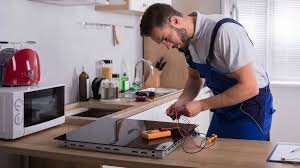
Induction Cooktop Common Faults Code
| Error Code | Meaning | Cause | Solution |
| E0 | No cookware detected or incompatible cookware | Non-induction cookware or cookware not centred properly | Use induction-compatible cookware and ensure it’s centered |
| E1 | Voltage error | Supplied voltage is too high or too low | Check the power supply, use a voltage stabiliser if needed |
| E2 | Overheating or temperature sensor issue | The cooktop or cookware is too hot, or the sensor malfunction | Turn off, allow cooling, and ensure proper ventilation |
| E3 | Abnormal cookware temperature detected | Rapid temperature change or incorrect cookware use | Use proper cookware; avoid sudden temp. changes |
| E4 | Fan malfunction or blocked ventilation | Fan issues or blocked vents | Clean vents, check the fan or contact support |
| E5 | Sensor Fault | Sensor malfunction or disconnection | Check sensor connections; they may need replacement |
| E6 | Internal circuit error | Electrical component failure | Requires professional inspection and repair |
| E7 | Temperature sensor error | Sensor reading out of range | Check and possibly replace the temperature sensor |
| E8 | Communication error between the main control board and display board | Wiring issue or board failure | Inspect and repair wiring; may need board replacement |
| E9 | Error with the relay control circuit | Relay failure or short circuit | Requires professional inspection and possible relay replacement |
| U1 | Low voltage or unstable power supply | Voltage too low or unstable power supply | Ensure stable voltage; may need an electrical check |
Do induction cooktops turn off automatically?
Yes, Induction Cooktops Turn Off Automatically
Induction cooktops are equipped with several safety features, including automatic shut-off.
Here are some common reasons why an induction cooktop might turn off automatically:
- Pan removal: The cooktop will automatically turn off when you remove the cookware from the cooking zone.
- Overheating: If the cooktop gets too hot, it will shut off to prevent damage.
- Timer: Many models have built-in timers that allow you to set a specific cooking time. Once the time is up, the cooktop will automatically turn off.
- Control panel lockout: If the control panel is accidentally locked, the cooktop may turn off.
Moreover, induction cooktops typically turn off automatically as a safety measure. They are equipped with sensors that can shut down the cooktop if it exceeds a specific temperature if cooking exceeds a set time limit, or if no cookware is detected. These features help prevent overheating and potential accidents, especially when using cookware like cast iron that retains heat well.

How to protect an induction cooktop?
Induction cooktops are efficient and safe. Bottoms: Choose but can still be scratched or damaged. Here are some tips to protect your induction hob:
- Use Pots and Pans with Smooth Bottom: Opt for cookware with a smooth base. This reduces friction and minimises the risk of scratching the cooktop.
- Use Scratch Protector Mat While Cooking: Place a scratch protector mat or stovetop cover under your pots and pans during cooking. This prevents direct contact with the glass surface and helps avoid scratches1.
- Cover the Entire Glass Surface After Use: Like a scratch protector mat, consider covering the entire glass surface with induction cooktop protector liners or stovetop covers. These prevent items from falling on the cooktop and scratching it1.
- Use Simmering Rings to Prevent Boil Overs: Simmering rings can help prevent spills and boilovers, protecting your cooktop from stains and damage.
- Choose the Right Cleaning Pads and Cleaners: Use cleaning pads specifically designed for glass cooktops. Avoid abrasive materials that could scratch the surface. After cleaning, polish the glass to maintain its shine1.
- Change Blades on the Scraper: If you need to remove stubborn residue, use a scraper with a fresh blade. Dull blades can scratch the glass.
- Cover Pots and Pans to Avoid Splatters: When cooking, cover your pots and pans to prevent food splatters. This keeps your cooktop clean and protects it from potential damage.
Related Articles:
Induction Cooktops How to use and how its work?
Why Do Some Induction Cooktop Say Not To Use Cast Iron? 2024
Does Induction Cookware Have To Have Flat Bottoms? Info 2024
Why Doesn’t Cookware Stick To Induction Cooktops? In 2024
Why Do Induction Stoves Make Those Annoying Clicks? 2024
Which Induction Cooking Temperature is preferable? Info 2024
Conclusion
Induction cooktops offer remarkable benefits, including fast cooking, energy efficiency, and a sleek design that enhances the modern kitchen. However, they have challenges. The most significant issues users encounter include heating problems, compatibility with cookware, and potential noise during operation.
Despite these minor drawbacks, the overall advantages of induction cooking, such as precise temperature control and safety features, make them a worthwhile investment. By understanding these common problems and implementing the suggested solutions, users can maximise the performance and longevity of their induction cooktops, ensuring a smooth and efficient cooking experience.
FAQs
Can you use regular pans on an induction cooktop?
No, regular pans that aren’t made from magnetic materials won’t work on induction cooktops.
Why do some induction cooktops make a clicking noise?
The clicking sound often comes from cookware with uneven or thin bases, which doesn’t conduct heat evenly on the cooktop.
Can you damage an induction cooktop with the wrong pan?
Yes, using cookware with rough or heavy bases can scratch the glass surface of the induction cooktop.
Is it worth buying new cookware for an induction stove?
If you plan to use an induction cooktop, investing in proper cookware is essential for smooth, efficient cooking.

